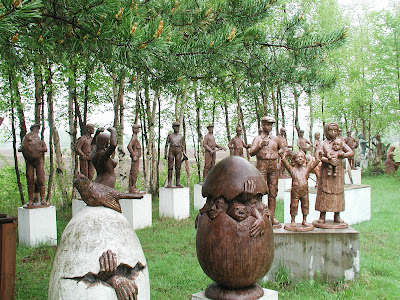As far as I know this outsider environment in the south of France has no special name, so I just refer to it as sculpture garden. It is characterized by a large number of animals, constructed by applying concrete to a model of iron gauze.
Life and works
This sculpture garden was created by Hubert Bastouil (1932-2022). Born in a family of farmers in Saint Martin Lalande, he at first had a job as a farmer, but when he was around age 27 he went to work in a metalworking company.
He showed a lot of technical insight and was able to improve the company's machinery in such a way that production could proceed much faster.
At age 40 Bastouil began his own company in metal products, especially windows. He managed this firm together with his wife Georgette. When in later years, because of health problems, Bastouil had to restrict his activities, Mrs Bastouil would continue managing the company.
All this years, Bastouil with his outspoken technical talent, did not show any urge to make artistic creations.
This changed however when mrs Bastouil thought it would be fine to decorate the garden with kind of a rock. Bastouil, who meanwhile had retired, tried to make one from concrete, to experience that his way of working was not so successful.
A garden with a zoo of sculpted animals
Then, when visiting the zoo in the Bois de Vincennes in Paris, he discovered that by applying layers of cement mixed with fiber on a model of iron gauze, one could make voluminous constructions.
Starting around 1997 it became his passion to construct life-sized sculptures of all kinds of animals.
The garden around the house meanwhile has an extensive collection, including a rhinoceros, a crocodile, elephants, deer, giraffes and so on....a complete zoo...
All together Bastouil has created some fifty life sized sculptures, the heaviest weighing some 800 kilo's.
The creations are rather naturalistic, both in appearance and in the way they have been painted. It has been reported that Bastouil uses images of animals in children's books as a model.
As far as possible and by appointment, the couple will welcome visitors.
Notre-Dame de Bassens
From the 12th century on the
sanctuary of Notre-Dame de Bassens is a spot of pilgrimage, located in the fields north of Saint Martin Lalande. Working for three years with a group of friends and using the same technique he applied for the creation of the sculptures, Bastouil has constructed on this spot a Lourdes grotto (from 2000 until 2002).
Hubert Bastouil passed away on October 10, 2022 at age 90.
Documentation, more pictures
*
Article in regional newspaper
Couleur Lauragais, nr 123, June 2010
* Weblog
Bruno se lance, with pictures of the
sculpture garden and the
Notre-Dame de Bassens
* Articles with a lot of pictures in
weblog De l'art improbable aux jardins insolites (January 2014) and
weblog Les grigris de Sophie (May 2014)
first published July 2011, revised August 2023
Hubert Bastouil
Sculpture garden
Route ancienne 113
11400 Saint Martin Lalande, dept Aude, region Occitanie, France
visits only on appointment
streetview






















